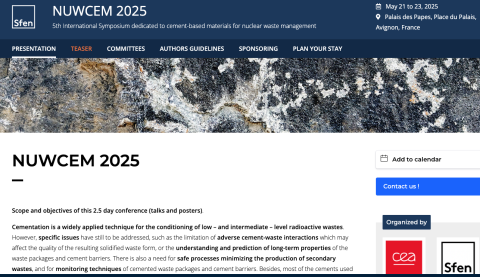
NUWCEM 2025
Cementation is a widely applied technique for the conditioning of low – and intermediate – level radioactive wastes. However, specific issues have still to be addressed, such as the limitation of adverse cement-waste interactions which may affect the quality of the resulting solidified waste form, or the understanding and prediction of long-term properties of the waste packages and cement barriers. There is also a need for safe processes minimizing the production of secondary wastes, and for monitoring techniques of cemented waste packages and cement barriers. Besides, most of the cements used nowadays have a high carbon footprint (e.g. Portland cement) or comprise supplementary mineral additions with limited availability in the near future (e.g. fly ash). In the same time, strong effort is made by the cement industry to reduce its environmental footprint. One consequence will be the progressive disappearance of binders with high clinker content (e.g. CEM I 52.5). Inversely, new cements are under development / standardization (CEM II/C-M, CEM VI), which may offer new prospects for nuclear waste management. The dismantling of old nuclear facilities will also produce waste with negligible or no contamination, which may be possibly reused as an alternative to primary aggregates. The design of novel cementitious materials with reduced environmental impact, but guaranteed long-term performance for surface or deep disposal, will thus be one of the challenges of the years to come.
The objective of the 5th edition of NUWCEM will be to promote the exchange of advanced information on the ongoing research and development activities dealing with cementation of nuclear wastes, from elaboration of waste packages with reduced carbon footprint to their final disposal.
